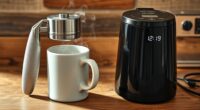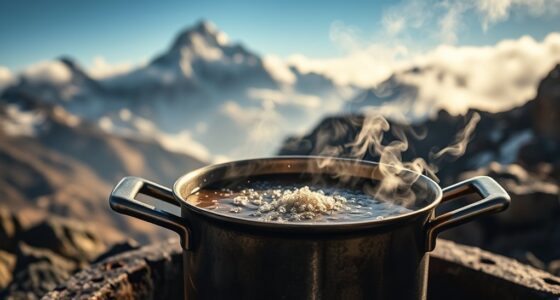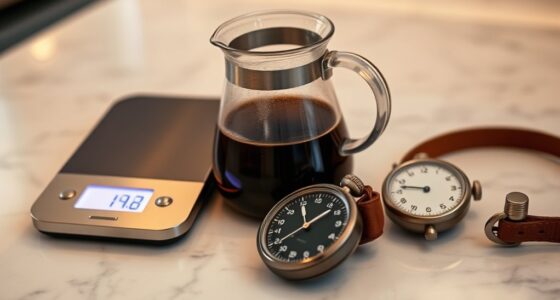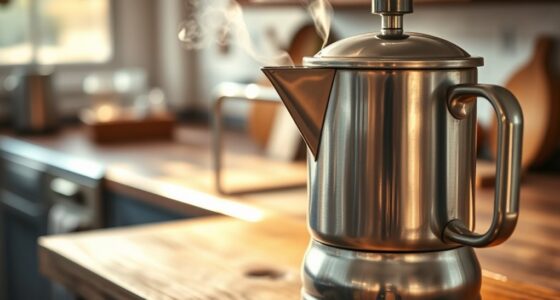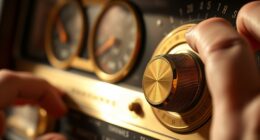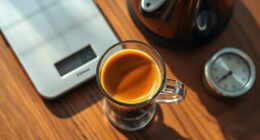Understanding coffee extraction is key to making better coffee, and both grind size and brew time play crucial roles. Finer grinds increase surface area, quickening extraction but risking bitterness if overdone, while coarser grinds slow things down, risking sourness if under-extracted. Too short or long brew times can lead to weak or bitter flavors. Perfecting these factors helps you achieve a balanced, flavorful cup—continue exploring to master the details behind these essential steps.
Key Takeaways
- Grind size controls surface area, influencing how quickly water extracts flavors from coffee grounds.
- Brew time determines the duration of extraction, affecting flavor strength and balance.
- Finer grinds speed up extraction but risk over-extraction, leading to bitterness.
- Coarser grinds slow down extraction, potentially causing under-extraction and sour notes.
- Properly balancing grind size and brew time achieves optimal flavor and prevents undesirable tastes.
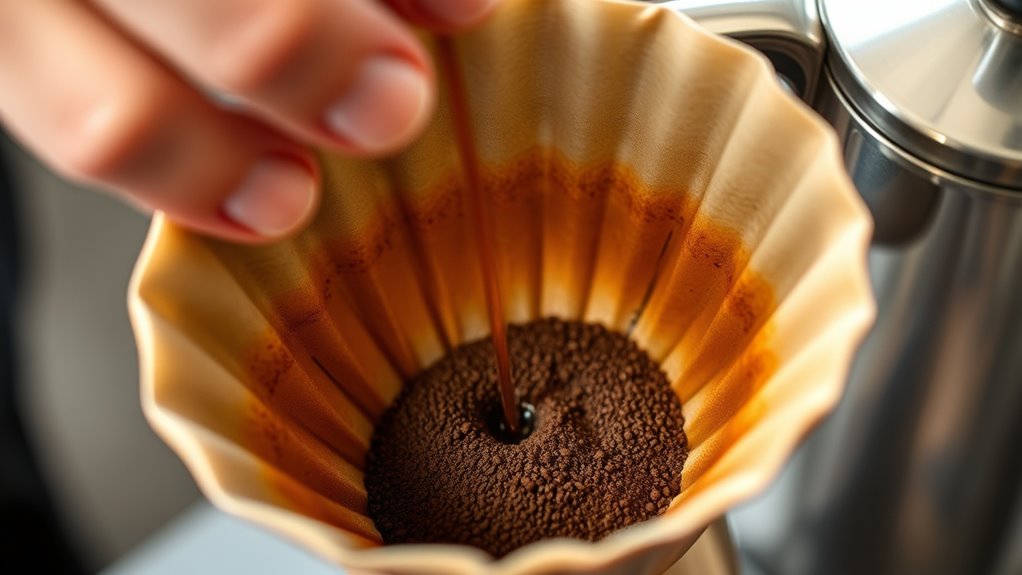
Coffee extraction is the process that transforms ground coffee and hot water into the rich, flavorful brew you enjoy. When you brew coffee, the goal is to extract just the right amount of solubles from the coffee grounds, creating a balanced and satisfying flavor. Too little extraction results in a weak, underwhelming taste, while over-extraction can produce bitterness and astringency. Achieving the perfect flavor balance hinges on understanding how factors like brew time and grind size influence extraction efficiency.
Your grind size plays a vital role because it directly affects how water interacts with the coffee particles. A finer grind increases the surface area exposed to water, allowing for quicker extraction. Conversely, a coarser grind slows down the process. If your grind is too fine, water might extract too much too fast, leading to over-extraction and bitter flavors. If it’s too coarse, you risk under-extraction, resulting in weak, sour notes. Finding the right grind size ensures that water flows evenly through the coffee, optimizing extraction efficiency and flavor balance.
Choosing the right grind size ensures even water flow and optimal flavor extraction.
Brew time is equally important. If you’re brewing for too short a period, the water doesn’t have enough contact time with the grounds, leading to under-extraction. This produces a brew that’s thin and lacking in depth. On the other hand, brewing too long can cause over-extraction, where undesirable compounds are pulled out, creating a bitter, harsh taste. The key is to match your grind size with your brewing method and adjust the time accordingly. For example, espresso requires a fine grind and a short extraction time, while French press coffee benefits from a coarser grind and a longer brew time.
When you pay attention to both grind size and brew time, you improve your extraction efficiency, meaning you’re getting the most flavor out of your coffee without overdoing it. This careful balance helps you achieve a harmonious flavor profile where each note shines through. It’s about more than just following a recipe; it’s about tuning your process to bring out the best in your beans. As you experiment, you’ll learn how slight adjustments in grind and time can dramatically change the taste, helping you craft a perfect cup every time. Mastering these elements allows you to control the extraction process and enjoy a well-rounded, flavorful coffee that hits all the right notes. Additionally, understanding glycolic acid benefits from skincare can be a reminder that proper exfoliation and timing are crucial for optimal results, whether in skincare or coffee brewing.
Frequently Asked Questions
How Does Water Temperature Influence Extraction?
Water temperature directly affects extraction by influencing water chemistry and mineral content. If it’s too hot, you’ll extract more bitter compounds, while cooler water might under-extract, leaving flavors dull. Ideal temperature balances the mineral content and water chemistry, ensuring even extraction and highlighting the coffee’s best qualities. By controlling temperature, you help achieve a harmonious brew, revealing the full potential of your coffee’s flavor profile.
Can Over-Extraction Make Coffee Taste Bitter?
Think of your coffee like a delicate symphony. Over-extraction plays the role of a discordant note, making your brew taste bitter. Yes, over-extraction can cause bitterness, disrupting the flavor balance you seek. The bitterness causes stem from extracting too many compounds, overpowering the nuanced flavors. To enjoy a harmonious cup, avoid over-extraction by adjusting brew time and grind size, ensuring each note in your coffee’s flavor profile sings clearly.
What’s the Ideal Grind Size for Espresso?
For espresso, you want a fine grind size to guarantee ideal extraction. A too-coarse grind results in weak, under-extracted espresso with sour flavors, while a too-fine grind can cause over-extraction and bitterness. Finding the right grind size balances the espresso flavor, producing a rich, smooth shot. Experiment with your grinder to achieve a consistency that extracts the best flavors without overdoing it, tailoring your brew to your taste preferences.
How Do Different Brewing Methods Affect Extraction?
Oh, the glorious world of coffee, where your brew method decides whether you sip nectar or bitter mud. If you use a French press, you get a bold flavor profile with rich oils; with drip, you get clarity and mildness; and with espresso, intense and concentrated. Your brew method controls extraction, shaping the flavor profile. Choose wisely, or risk turning your morning into a caffeine catastrophe.
Does Coffee Origin Impact Optimal Extraction Time?
You might wonder if coffee origin impacts ideal extraction time. The answer is yes, since different origins have unique coffee flavor profiles and bean characteristics, affecting how quickly flavors extract. By paying attention to this, you can achieve brewing consistency and highlight the specific notes of each origin. Adjusting brew time based on origin helps you maximize flavor, ensuring a balanced, satisfying cup every time.
Conclusion
Now that you know how brew time and grind size impact your coffee, you’re better equipped to brew the perfect cup. Remember, it’s all about finding that sweet spot—don’t let the perfect brew slip through your fingers. With a little patience and experimentation, you’ll master the art of extraction. So, keep at it, and soon enough, you’ll be savoring a cup that hits the spot every time. Cheers to brewing your best!

